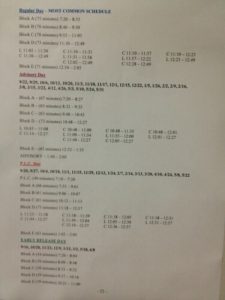
Last year, Walpole High School administration implemented the Advisory and PLC programs. The 2011-2012 schedule consisted of no homeroom, and Advisory and PLC blocks once a week (as long as there were no half days); however, problems were immediately evident. The schedule on PLC days and Advisory days were confusing for teachers and students, and the schedule was not consistent from week to week. To fix this problem, a new schedule has been proposed for the 2012-2013 which consists of daily Advisory blocks in the middle of the day, with an extended advisory on Friday, and PLC blocks at the end of the day on Tuesday. However, the real problem with Advisory and PLC is not necessarily the confusion surrounding the schedule, but rather the confusion surrounding the purpose of Advisory and PLC.
The motivation behind the Advisory Program was to create a relationship between a student and a teacher by providing 20 minutes a week for a small group to meet with an assigned teacher. However, many students did not feel comfortable with the idea. For example, Senior Rebecca Goula said, “It’s a forced relationship with a teacher who I have no desire to have a relationship with.” Goula’s thoughts are echoed throughout much of the Senior Class, but the feelings could just be caused by the late implementaion of the program. For this year’s graduating class, Advisory was introduced during junior year. By this time, many students had already developed close relationships with teachers and classmates, and being placed into a classroom with randomly selected students and a randomly selected teacher seemed futile. “We were all reluctant to do it because it started junior year,” said Senior Christine Drogan. In addition to the late start Advisory had for some students, the inconsistency of it prevented many students from feeling comfortable with their advisors. Although it was proposed that Advisory would be held once a week, this was difficult to maintain. During weeks when there was an early release day or no school, PLC and Advisory would not be held. So, holding Advisory everyday in order to eliminate its inconsistency might be a step in the right direction. Senior Meaghan Lescault said, “Maybe better bonds will be developed if advisory is everyday instead of a few times a month.”
In terms of the Advisory Program itself, it can largely be deemed inconsistent. Some students (Especially sophomores and freshmen who have had it for two years) love advisory; however, some students detest it. And sadly, both groups of students are equally passionate about their feelings. So where does this difference come from? For the most part , this difference comes from one place: the randomly selected advisor.
Depending on the faculty member, an advisory could be a fun place where you play games and use sidewalk chalk outside, or it could be an awkward space where the teacher may try to lead an unsuccessful discussion about the pressures of teenage life. But — this inconcistency is not the teacher’s fault. The Advisory Program simply needs more direction, not a new schedule.
While meeting everyday might help with this process, the goals of Advisory need to be reestablished. Rearranging the schedule will not fix any problem, but rather disguise it and breed more distrust from students. Better, guided objectives for Advisory will give advisors an established agenda, and students might be more willing to participate. Having advisory everyday is a good idea, but it will not accomplish anything without new goals for the program itself.
Meanwhile, while the teachers effectively use their PLC time, the PLC timeslot has become a time that students look forward to because it gives them extra time to sleep. For the 2012-2013 potential schedule, the PLC will take place at the end of the day. Students will be released from school at 1:40 if they are not required to stay, but will not be released until 2:20 if they are required to attend PLC. “I don’t think the PLC day will work,” said Drogan. Staying after school for an extra fifteen minutes may not seem like a significant amount of time, but it can impact students’ after school schedules. For students who take the bus, getting out at 2:20 might cause them to miss the bus, and getting out at 1:40 will give students an extra half hour where they have nothing to do.
The proposed 2012-2013 schedule change might be better, but it will not fix the problem of inconsistent student experiences across Advisories. Rather, it will only perpetuate that inconsistency. If the goal of it is to establish a relationship between students and teachers, all advisors should be on the same page.














